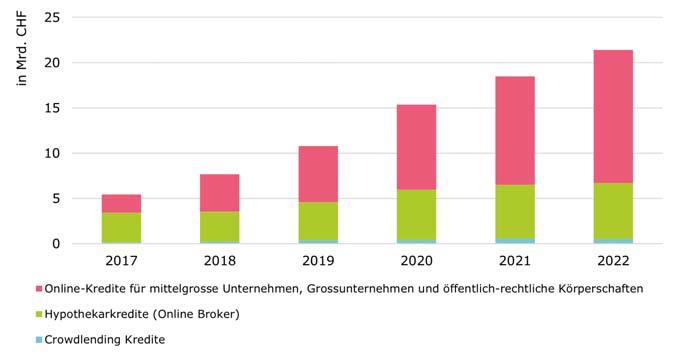Online debt market cracks the 20 billion franc barrier
A study by the Lucerne University of Applied Sciences and Arts shows that the brokering of loans to companies, private individuals, municipalities and cities via the Internet continues to grow. Marketplace lending platforms of this kind will broker a volume of CHF 21.4 billion in 2022. This is four times more than in 2017.

The business models of marketplace lending platforms are fundamentally different from those of banks. They merely act as online intermediaries and do not take deposits from customers onto their own balance sheets. Nor do they grant loans themselves. Institutional and private investors can thus invest in debt capital. In 2022, debt capital with a volume of CHF 21.4 billion was brokered on online platforms. In the previous year, the figure was 15.4 billion francs. This shows the increase of 16 percent. In the last five years, the volume has even quadrupled. This is shown in the latest edition of the Marketplace Lending Report published by the Lucerne University of Applied Sciences and Arts (HSLU), the Swiss Marketplace Lending Association (SMLA) and APEX Group. It is the only comprehensive analysis of debt financing by Swiss companies, public corporations and private individuals via platforms on the Internet.
Online platforms popular with public-sector bodies
However, the growth figures for the various segments of Marketplace Lending differ significantly. At CHF 13.7 billion, loans and bonds for medium-sized companies, large corporations and public-sector entities account for almost 65 percent of all debt financing granted via online platforms. "For public-sector entities such as municipalities, cities or, for example, hospitals and transport companies, marketplace lending has become an important financing pillar," says study co-author Prof. Dr. Andreas Dietrich. According to the study authors' estimate, they now obtain around 15 percent of their external financing via online platforms. "Many of them have now recognized that this financing option can be attractive, especially from a price perspective," says Dietrich.
Less growth in online mortgage lending
Mortgage loan intermediaries achieved a volume of CHF 6.2 billion in 2022. According to the study, this gave them a market share of around 3.5 percent. However, the growth momentum of online intermediary platforms has steadily slowed over the past three years. There are many reasons for this. They include higher interest rates, the disappearance of Credit Suisse and slow changes in customer behavior. Individual mortgage intermediaries have therefore also adapted their business model and are focusing less on platform business with direct contact to end customers (B2C area). The study authors therefore expect the online mortgage market in the B2C area to stop growing in the next two years.
Institutional Investors and FinTechs Important for Swiss Financial Market
With the exception of crowdlending, marketplace lending is only open to institutional investors. But even with crowdlending, around half of the invested capital comes from institutional investors. Pension funds and external asset managers in particular invest actively via crowdlending platforms or indirectly via corresponding fund solutions. "For the development of the market in Switzerland, the commitment of institutional investors is absolutely essential, as the demand for credit can be served quickly due to the high investment volumes," says co-author of the study Dr. Simon Amrein.
Source: www.hslu.ch









